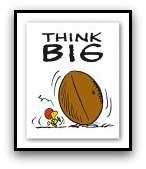Comic Strips are Almost as
Well Read as Comic Books!
Comic strips are almost as popular as comic books in some circles. So I would be remiss if I didn’t have a couple of pages about them. Strips have ended up in a multitude of newspapers and other media all over the world. Most people who read the Sunday paper can’t pass up the comic section. I know I sure can’t.
Comic-strips are short strips or pieces of sequential art, telling a story. They are drawn by cartoonists and are published on a recurring basis (usually daily or weekly) in newspapers, magazines or on the Internet. In the UK and Europe they are also published within comic magazines. A strip's story can continue over three pages or more. They usually communicate to the reader via speech balloons.
Strips can be humorous like Beetle Bailey, Hi & Lois, or Hagar the Horrible, with no continuous story but ends with a typical punch line. Or they can have a soap opera like continuity (like Judge Parker or Little Orphan Annie) with serious story lines in serial form. They are, however, nonetheless known as "comics" – though the term "sequential art", coined by cartoonist Will Eisner, is becoming increasingly popular.
Comic-Strips and Their History
In America, the great newspaper icons of the time, Joseph Pulitzer and William Randolph Hearst were continuously warring with each other during the late 1800’s and early 1900’s. This created a great popularity in comic-strips and “The Little Bears” was the first American comic with recurring characters. Then the now famous, “Yellow Kids” became the first color comic and was part of the first Sunday comic section in 1897. This is where the term “yellow journalism” supposedly formed its origin. Mutt and Jeff was the first daily comic-strip appearing in 1907.
Comic-strips in a mannor of speaking, began in Germany in 1865 with the creation of “Max and Moritz”, a strip about two mischievous youngsters. This strip inspired a German immigrant, Rudolph Dirks, to create The Katzenjammer Kids in 1897. This strip has been labeled as the first comic strip in the modern sense of the term. Familiar comic-strip iconography such as stars for pain, speech and thought balloons, and sawing logs for snoring originated in Dirks' strip.
Hugely popular, Katzenjammer Kids was responsible for one of the first comic-strips copyright ownership suits in the history of the medium. Dirks left Hearst for the promise of a better salary under Pulitzer (unusual, since cartoonists regularly deserted Pulitzer for Hearst).
Hearst, in a highly unusual court decision, retained the rights to the name "Katzenjammer Kids", while creator Dirks retained the rights to the characters. Hearst promptly hired a cartoonist named Harold Knerr to draw his own version of the strip. Dirks renamed his version Hans and Fritz (later, The Captain and The Kids).
Thus, two versions distributed by rival syndicates graced the comics pages for decades. Dirks' version, eventually distributed by United Feature Syndicate, ran until 1979. And hundreds of comic-strips followed, as we are now very familiar with. Many have been running for decades.
Comic-Strips in Hollywood
The last decade and a half has shown an amazing popularity in the creation of superhero epic movies. But comic- strips have shown popularity since the late 1930’s. Among the list of popular strip characters that have made it to celluloid are:
- Annie (1982), based on Little Orphan Annie created by Harold Gray
- Astérix & Obélix: Mission Cléopâtre (2002), based on Asterix
- Astérix chez les Bretons (1986), based on Asterix
- Astérix et Cléopâtre (1968), based on Asterix
- Astérix et la surprise de César (1985), based on Asterix
- Astérix et le coup du menhir (1989), based on Asterix
- Astérix et Obélix contre César (1999), based on Asterix
- Asterix in Amerika (1994), based on Asterix
- Astérix le Gaulois (1967), based on Asterix
- B.C.: A Special Christmas (1981), based on B.C.
- Beetle Bailey (1989), based on Beetle Bailey
- Blondie (1938) and 27 sequels from 1939 to 1950, based on the comic-strip created by Chic Young
- Brenda Starr (1989), based on the comic strip created by Dale Messick
- Dennis the Menace (1993), based on the comic-strip created by Hank Ketcham
- Dick Tracy (1990), based on the comic-strip created by Chester Gould
- Flash Gordon (1980), based on the comic-strip created by Alex Raymond
- Garfield (2004), based on the comic-strip created by Jim Davis
- Hägar the Horrible (1989), telefilm based on the comic-strip Hägar the Horrible by Dik Browne
- Les douze travaux d'Astérix (1976), based on Asterix
- Modesty Blaise (1966), based on the comic strip by Peter O'Donnell
- My Name is Modesty (2003), based on Modesty Blaise
- Popeye (1980), based on the comic-strip created by E.C. Segar
- Prince Valiant (1954), based on the comic-strip created by Hal Foster
- The Phantom (1943), based on the comic strip created by Lee Falk
- The Phantom (1961), based on the comic-strip created by Lee Falk
- Phantom 2040: The Ghost Who Walks (1994), based on the comic strip created by Lee Falk
- The Phantom (1996), based on the comic strip created by Lee Falk
- The Phantom (2006), based on the comic strip created by Lee Falk
Are
any of these your favorites? I also thoroughly enjoyed the old Flash
Gordon and Buck Rogers serial episodes when I was young. And as comic
book superheroes and characters become more sought after in Hollywood, I
would imagine that more of our favorite strips will make it to
the wide screen. What do you think?
More for Comic Strip Fans
Here is a pretty amazing site that I have found that offers up quite a plentitude of comic strips . Be careful though or you could get engrossed all day and you might want to come back here.
You may also find a few pieces of literature worth reading at Amazon that may tickle your taste buds. Just click the image at the left. Don’t stay too long though, and come back here.
If you want to keep up on the varied and interesting activities going on in the world of comic books, then feel free to sign up for my newsletter “Comics Galore” in the form below. And by all means, I would love to hear your comments and opinions on comic strips as opposed to comic books. You can sure leave them for me at my contact page in the menu at the left. I may even be able to include them in my newsletter. I thank you ahead of time.
Dave Gieber










New! Comments
Have your say about what you just read! Leave me a comment in the box below.